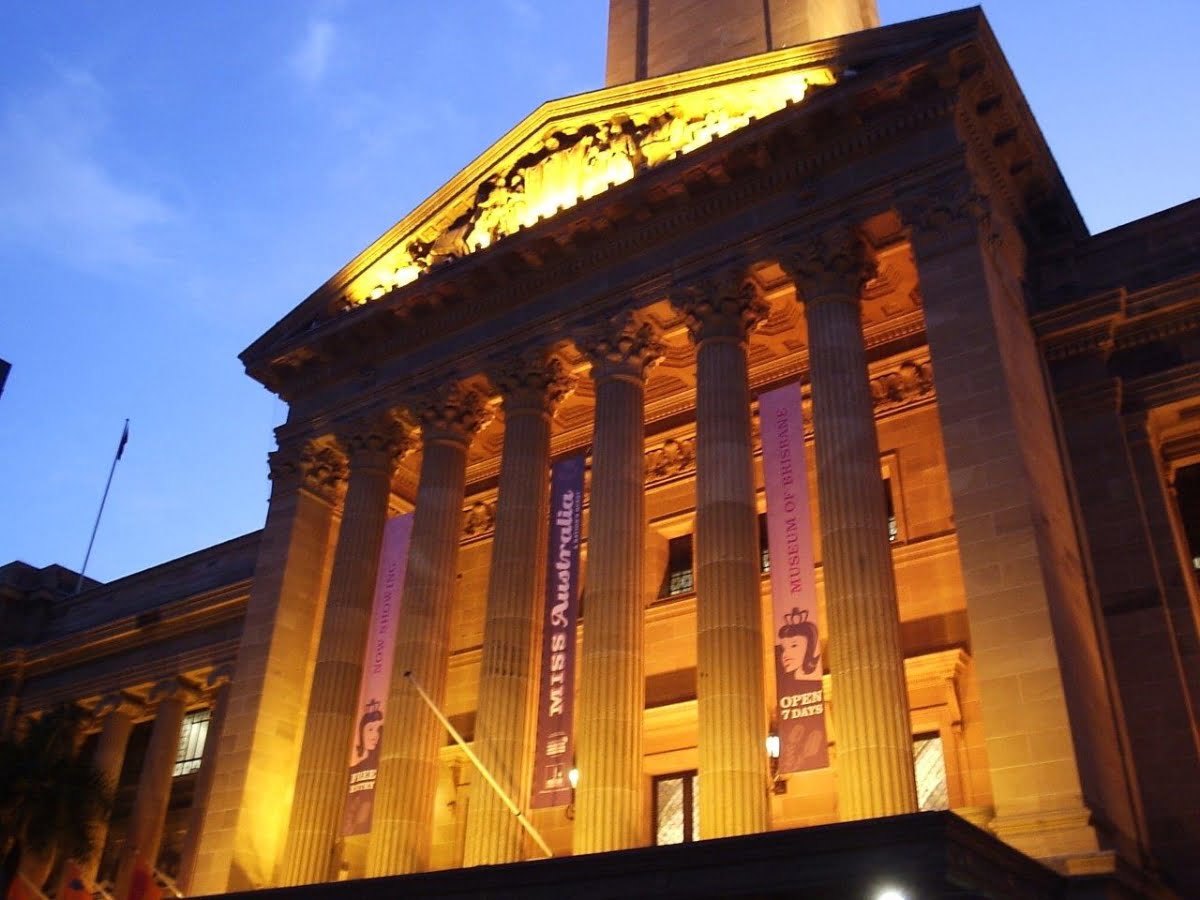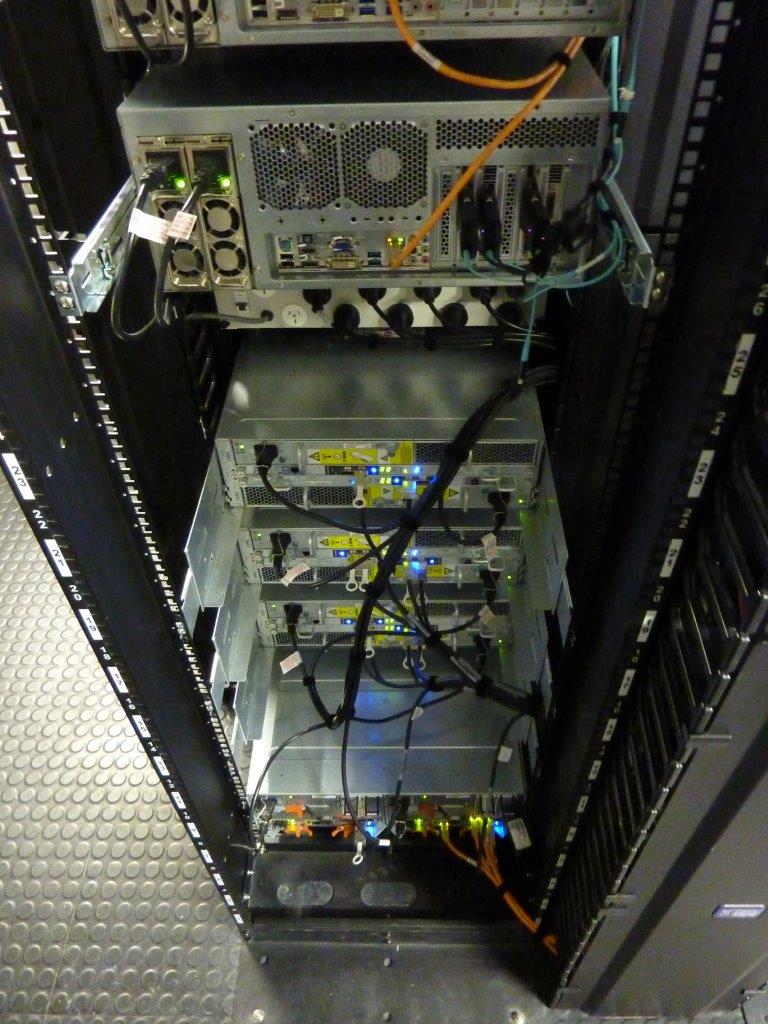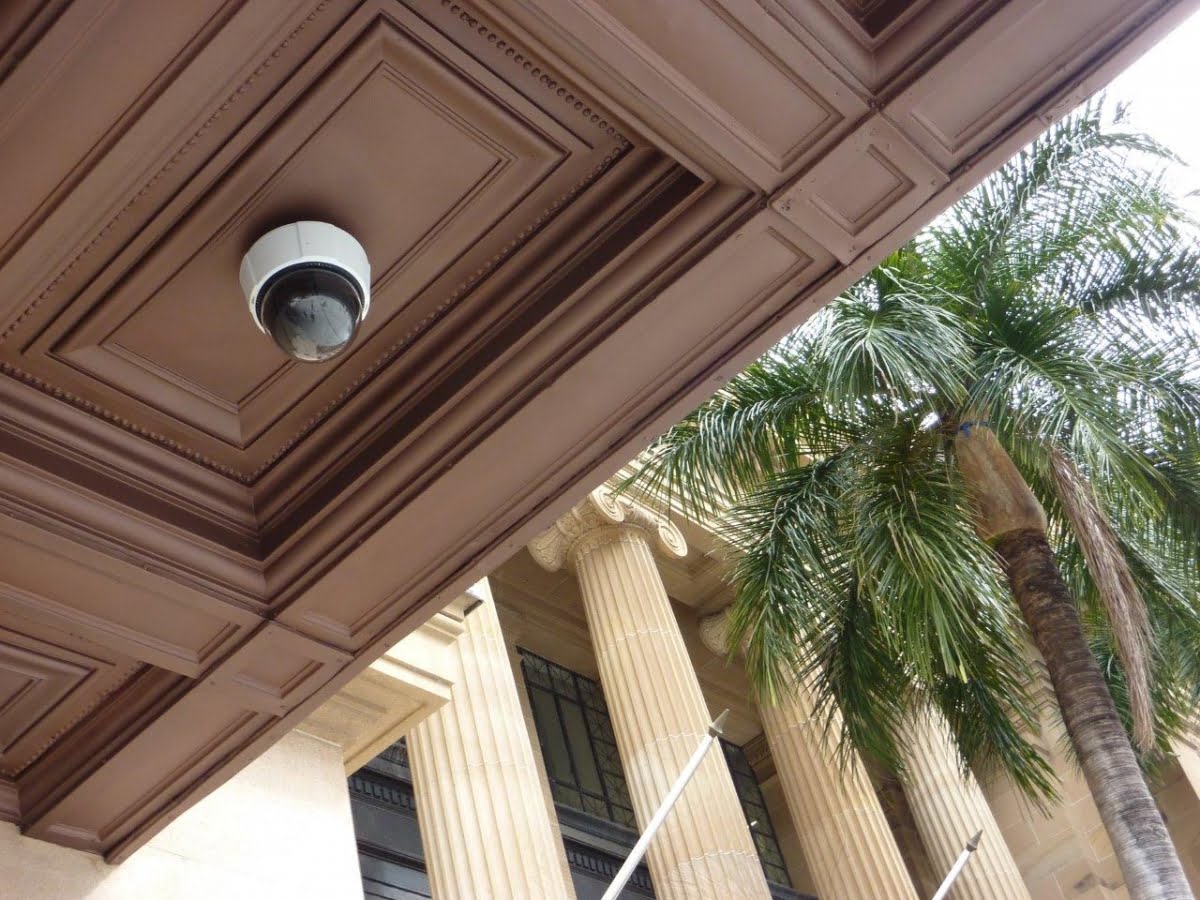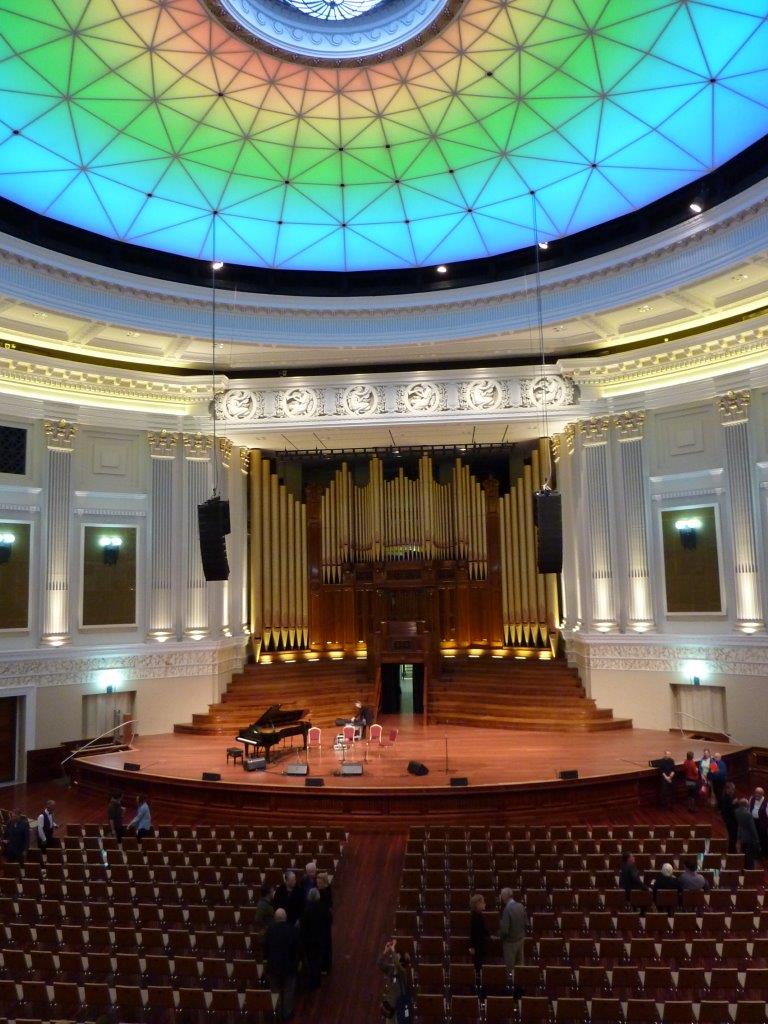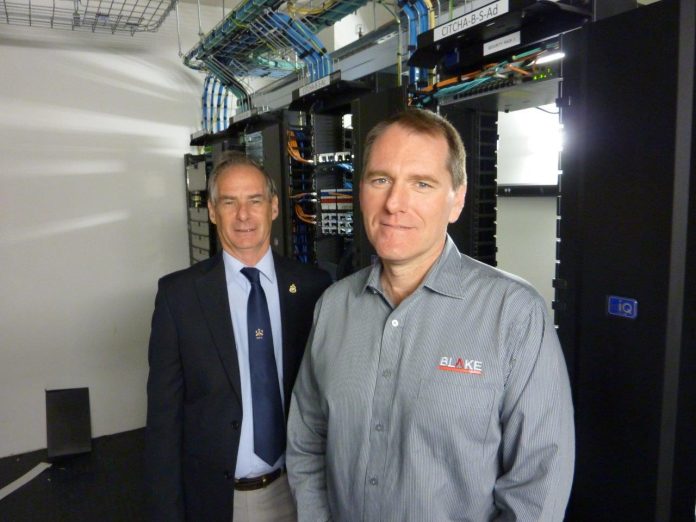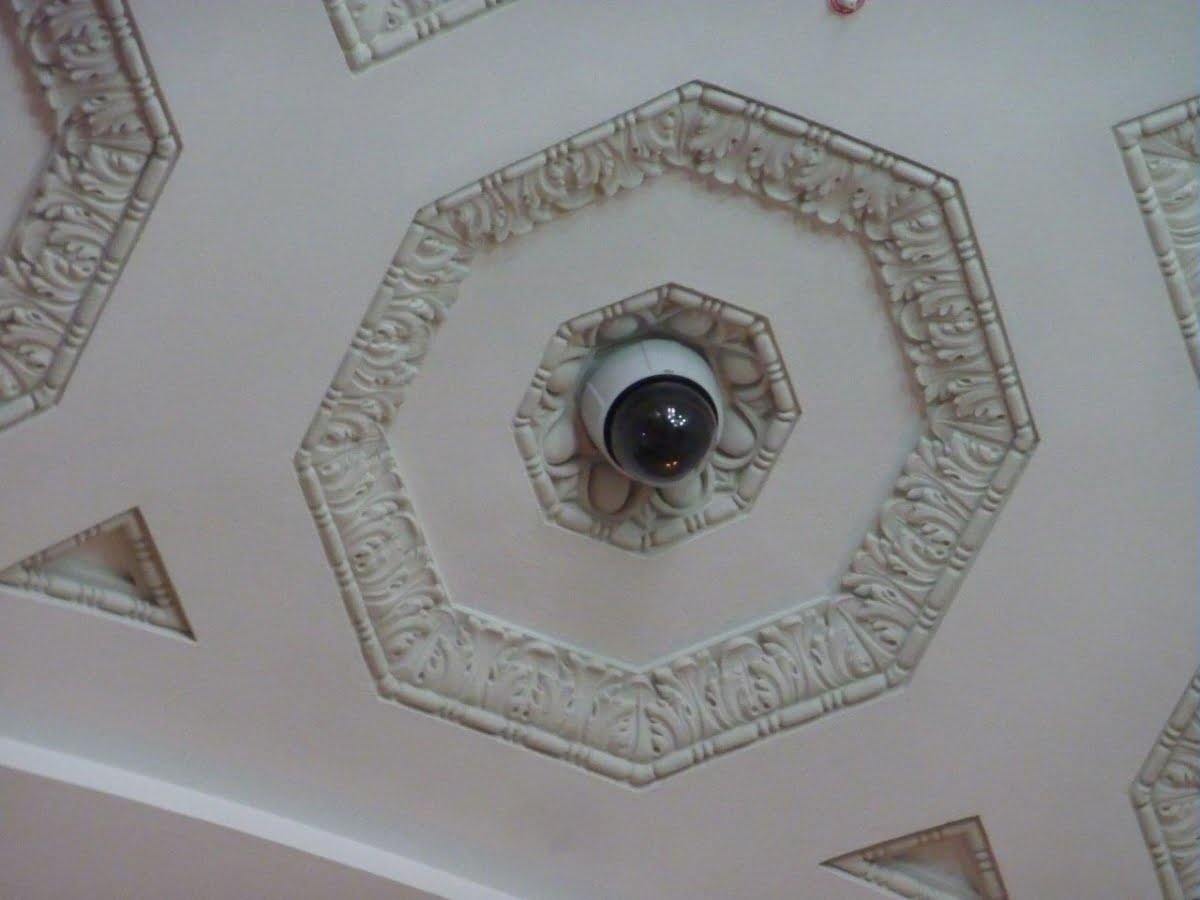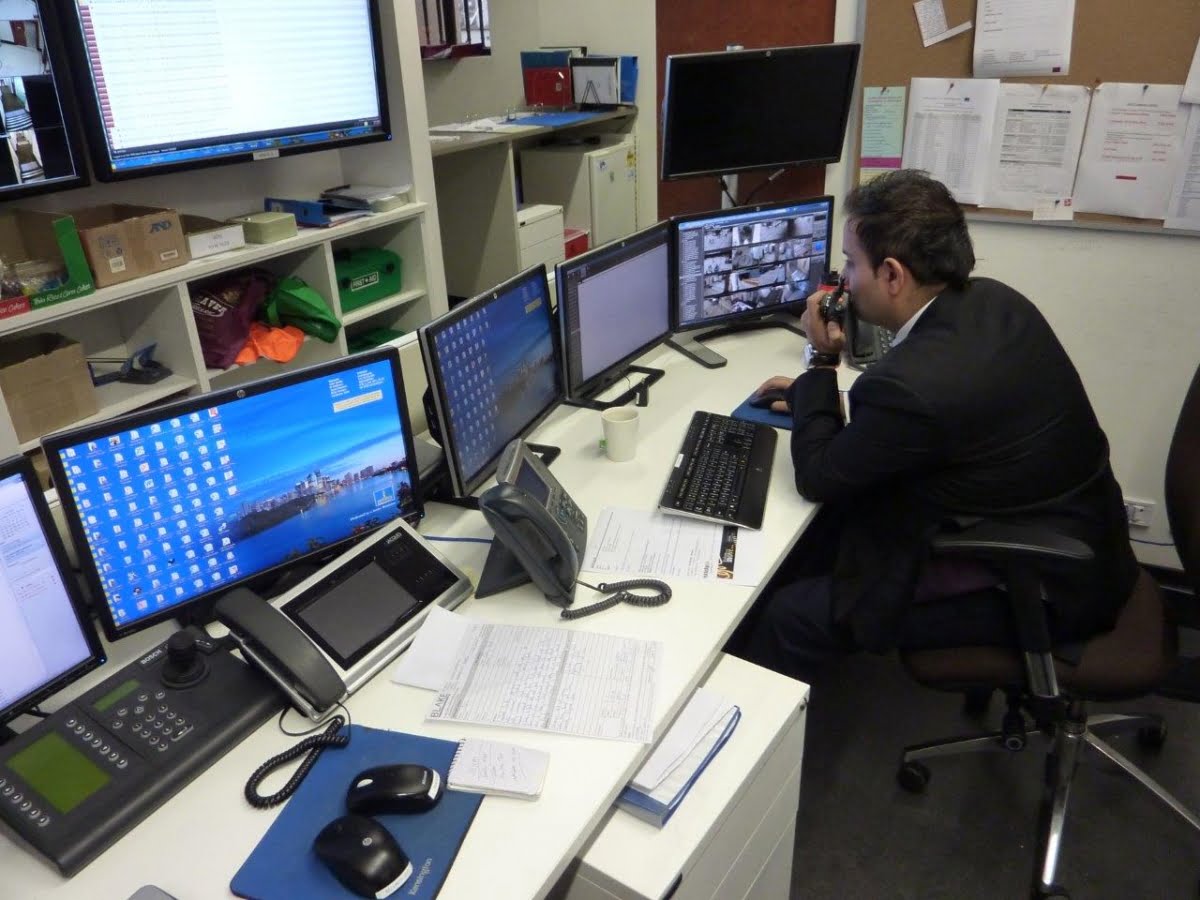BRISBANE City Hall, presiding over bustling King George Square with entrances at King George Square and on Ann and Adelaide Sts, is listed by the Register of the National Estate and is one of Australia’s most stately public buildings. But the 1930 building was constructed on wet ground and over decades this led to subsidence, concrete cancer and problems with corrosion in aging wiring.
A ground-up restoration was needed so the site closed at the end of December 2009, was completely gutted and rebuilt as closely as possible to Hall & Prentice’s original specifications. The $A215 million restoration project was thorough in the extreme. Floorboards were taken up and re-milled; doors were removed, taken back to bare timber, repaired then re-hung; the Auditorium’s dome was structurally strengthened and its 4300-pipe organ was removed and fully restored.
While this was going on, extensive excavation and construction works took place underneath, adjacent to, and within City Hall that significantly increased and maximised floor space in the original 3-storey, single basement structure.
The results are stunning. City Hall known to locals as the ‘People’s Place’ re-opened to the public in April 2013 with an expanded role as Queen of Brisbane’s tourist attractions, able to cater to a range of functions and public gatherings in multiple function/reception rooms, or the striking 1600-seat Auditorium.
The Museum of Brisbane was relocated into a purpose-built facility on the rooftop of City Hall, managing exhibitions, as well as building and clock tower tours. There are 2 privately-operated cafes in City Hall, the Red Cross Cafe and the iconic Shingle Inn, the period fittings of latter were stored during the renovation and then rebuilt. As well as direct access to an adjoining Council owned multi-level carpark, an industrial kitchen was installed in the basement during the renovations to handle catering.
The demands on this building are heavy – it’s operational 20 hours a day. There are 400 staff back of house and front of house is open to the public with around 2800 visiting daily. Some of the site’s uses include a coffee club, an over-50s club, and a weekly concert in the Auditorium. And while most Council staff are located in the 28-storey Brisbane Administrative Centre just up the road, Brisbane City Hall retains the offices of the Lord Mayor of Brisbane and Council Chambers, with all its myriad period details now painstakingly restored.
What’s interesting to the visitor isn’t just the preservation of period features but the time-travel invisibility of modern building services. This is deliberate. The building services work undertaken during the renovation included the replacement of all City Hall’s electrical, mechanical, IT, fire, hydraulic, security and communications systems.
As part of this process, an $A3 million integrated electronic security system was installed, monitored from an in-house control room. This system has a combination of standout features I’ve not seen elsewhere. There’s people (and asset) tracking. There’s video analytics for movement and object detection, day and night. And there’s people counting.
It’s an impressive building. As I arrive to take a look at the site with Paul Rishman, corporate security manager of Brisbane City Council and Blake Systems’ Anthony Brown, I can half imagine the challenges, the battle to respect the fabric of this towering building, with its glowing stone facades, thick internal walls, giddy ceilings, dark corners, innumerable corridors, hundreds of internal doors and multiple public entry points.
When we head into the main entrance my expectations are realised. The building is a compilation of layer upon layer of detail. Looking up, the ceiling scrapes the sky. Just getting up to install cameras on the decorated plaster would have been a production – finding a spot to locate a camera would be impossible. Or would it? What’s that I can see in the middle of the ceiling’s organic moulding? Is it…an Axis PTZ camera? And turning I see above the lintel, tiny as a Christmas beetle, an Axis people counting camera, peering down at the crowd.

Planning the system
According to Rishman, whose role in the project was to oversight the security function, there was a surprisingly simple list of operational requirements.
“First of all, Brisbane City Hall had to be open to the people, it had to be a place for the people,” he says. “Next, we needed to be able to keep the site open or lock it down to the last door. And finally, we needed to be able to track people throughout the building. That really was the essence of this solution, operationally. From these basic needs we moved on to the systems we should use and how should we integrate them to achieve our goals.”
Keeping the site open was a key aspect of the system, agrees Blake Systems’ Anthony Brown.
“Management kept saying to us over and over, ‘It’s the people’s place, don’t affect the people’. It was repeated like a mantra. That really had an impact on everything we did, from system design to product choice,” he says.
Given the complexity of the project, there was an extended period of planning stretching all the way back to 2008.
“The project planning was a lot longer than normal,” explains Brown. “It’s an important site and there were many interest groups. When it came to planning the system it was very much what can we do with the technology that we have today, while leaving the system open to be upgraded, or to be moved to a new control centre – just by unplugging it from one data outlet and plugging into another.
“This meant that from the outset we embraced the IT world and I want to emphasise this,” Brown explains. “Everything possible in this Brisbane City Hall solution is commercial or enterprise grade IT infrastructure.”
“Brisbane City Hall had to be open to the people…we needed to be able to keep the site open or lock it down to the last door…and we needed to be able to track people throughout the building”
According to Rishman, another key operational element of the site is that it’s large, complex and busy, yet it only has 2 security officers 24/7. Running at this level of efficiency, it’s vital that these officers be empowered by technology to work as effectively as possible.
“We have an operator and a protection officer on-site 24/7 who share the roles of managing the control room and patrolling the site,” Rishman explains.
“This system is very much designed so that the entire building can be managed by this very small team and that meant we needed an intelligent solution with proactive detection and reporting capabilities.”
Rishman says the security planning team drew on its long experience managing security at Brisbane City Hall to establish requirements for the new system.
“We took into account our highest risk points when designing the new surveillance and access control system and we also knew the ways in which our risk profile changed throughout a 24-hour period,” he explains.
“With this in mind we worked towards a system that allowed us to have the building open and under surveillance during the day, and totally locked down at night using a combination of access control and physical locks. During the day and after hours, the video surveillance system’s ability to detect and report movement comes into play.”
Rishman says a key proactive capability of the solution involved the installation of Ekahau, giving the ability to track the movements of key personnel (and assets) across the site. Ekahau is also used to track the movements of contractors in back of house, who need to be restricted in terms of movement in an area not fully governed by access control.
The original system at City Hall was modest. It included a Gallagher access control and alarm system supporting about 60 doors and alarm inputs. There were also multiple DVRs supporting around 25 cameras focused on external entrances. It offered basic record and playback with no integration capability.
And now we get to the fun part – the combination of sub systems that comprise the overall Brisbane City Hall solution. At the heart of the CCTV solution is a Genetec VMS which also manages 120 channels of AgentVi video analytics in real time. There’s a selection of around 200 Axis 720p HD cameras. The cameras include fixed domes, mini domes, 9 of those teeny people counting cameras and many flexible 5534 720p PTZ domes.
Rishman points out something interesting here. The choice of the Axis 5534 PTZ cameras was based on their ability to give fixed views on multiple time-based presets, while retaining the capacity to adjust these presets without the need for maintenance call-outs. There are also Axis cameras in all the lifts, except the heritage-listed lift to the clock tower.
“We went big with analytics,” Rishman tells me. “Our security officers can’t be everywhere and when you walk around the site and understand its complexity you can see why we needed every camera to be a security officer.”
Taking care of network requirements is Juniper Networks gear, while storage solutions are from EMC. The access control solution is from Kiwi tech house Gallagher and it was expanded to 198 doors (all prox), mostly in the front of house. Gallagher’s GMS is integrated into the video wall to allow operators to synthesise events with camera views on the fly. It’s not seamless integration but it works. Full seamless integration is planned for September.
While the Gallagher system handles access control front of house, in the back many locks are mechanical, in part to preserve the fabric of old doors, in part because some doors defy electronic solutions. To give the best possible management of mechanical locks, City Hall installed a Morse Keywatcher managed by the Gallagher system, which allows the security team to secure and track its hundreds of mechanical keys.
Finally, there’s Ekahau, an RFID-over-Wi-Fi real time location system that is used in conjunction with tags that can be carried by staff or attached to assets. Ekahau doesn’t make commercial security products. Instead its systems are designed for use in hospitals but the core functionality is the same.
According to Brown, the attraction of Ekahau was the fact it uses Wi-Fi and there are 60 dedicated Wi-Fi points spread around the site solely for this purpose. This system can also sit transparently on any commercial Wi-Fi network.

The control room
Our first port of call is the control room. It’s a long space with high ceilings and barred windows at one end giving good natural light. This is a nice control room, if a little tight-waisted – nothing like some of the dungeons I’ve seen in the past. There’s a pair of workstations complete with desk top monitors along one wall and hanging before them is a very comprehensive video (and management) wall.
Video walls are getting more substantial as organisations look to maximise the abilities of smaller teams of security officers supported by greater sub system integration and expanded camera numbers. This one is especially rich I think to myself, as Rishman walks me through.
“What we have here are 4 large monitors variously giving fixed and sequential views across layers of the building,” he explains. “This allows our operators to view geographically related cameras and follow events more easily. And on this next monitor you can see we’ve changed from a typical 16 x 9 configuration to show all the corridor views in a 9×16 configuration throughout the building.”
I pay close attention to these vertical camera views. It’s the first time I’ve seen Axis Corridor View running live and it suddenly makes a lot of sense. Field of view is exemplary.
“This next monitor we have pre-loaded with preset tabs so during specific events, our operators can hit the tab and the Genetec system will populate the screen with pre-selected camera views,” Rishman says.
“And finally, we have another monitor that allows our security operators to select the views they consider most important, depending on events of the day. As you can see, it’s set to the entry at the moment but it might be any group of camera views our security team decides will help. It’s drag and drop – very easy to use.”
Also part of the video wall is a Gallagher alarm viewer showing access and alarm events and there’s a CCTV alarm viewer supporting those 120-channels of AgentVi analytics. According to Rishman, the security team uses analytics for object-abandoned and object-moved alarms. The video wall also includes an Ekahau screen.
“The Ekahau allows us to protect our internal staff and ensure contractors don’t end up in areas they should not be,” Rishman says. “This is important because the site is open except for the Lord Mayor’s area/s.”
Finally there’s data from the people counting cameras at the main entrance, the lifts and other key points that help with management of visitors. This data is integrated into the Genetec VMS.
Looking at the banks of monitors, I can’t help asking how deep the integration of all these clever sub systems goes, or could go in the future.
“The way the system is currently configured, Genetec is handling CCTV and manages the AgentVi video analytics and people counting,” Brown tells me.
“The Ekahau system is not integrated with Genetec today but that’s the next step – the APIs are there. We are just waiting for the IT team to sign off on it.
“Additionally, Genetec has a Map Manager interface and the next-gen will be 3D so we’ll be able to put the Ekahau into it and literally the camera will alert us to an intrusion, show an image and show a 3D representation of the room.
“We can also do a lot with the Gallagher GMS,” says Brown. “Sometimes we use the GMS as the pull and feed it to Genetec and sometimes we use the Genetec as pull and feed it to Gallagher, it depends whether it’s a CCTV-heavy or an access control and alarm-heavy application.”
“This was a construction site so there was work going on everywhere. It meant there were hurdles that were totally unexpected”
The control room is the perfect location to get an idea of CCTV system performance in the wild. This is a busy site – there are people everywhere in front of house. The internal shots from the Axis cameras are strong. They’re doing a good job with low light and backlight. I’m surprised to see so many of the cameras have extensive light fittings in the foreground thanks to the low-hanging period pendant/chandelier-style lights and the high ceilings. It’s a tough gig to handle but not beyond these Axis cameras.
As I expected, there are a number of locations in corridors away from external walls and close to doors that are quite dark. I didn’t bring my light meter on this trip but I estimate most these dark patches are around 10-15 lux. Thanks to enormous windows, there’s a surprising amount of natural light inside City Hall during the day.
“Yes, it was a bit of a challenge in some of those scenes – the lifts and those low light areas,” agrees Rishman, as we look at the monitors. “We do have our lights on all the time so light levels are fairly consistent across the site but you can see there are some darker areas where the Axis cameras are performing very well.”
It’s worth pointing out again that thanks to the long lead time on this project some of the best new camera releases could not be considered because they were not available. That’s simply one of the challenges of vast public applications like this one – processes are naturally tectonic.
“All the technology was purchased 18 months ago so the models of cameras that were available to be specified at that time are now last generation,” Brown explains. “As you can see they’re still very good but obviously an Axis Lightfinder changes everything.
“And there are challenging scenes on this site. There’s backlight, low light and in the museum there’s low light combined with flashing lights as part of the displays. The Axis cameras are acquitting themselves well throughout.”
An interesting aspect of this site relates to the nature of Brisbane City Council, one of the largest local government organisations on the planet. Because Council is homogeneous, it gives the team a lot of scope for integration of other Council buildings and surveillance systems in the future, as well as allowing redundancy of operations between multiple sites.
“This control room has the ability to be used as a backup for our operations centre which is 5-6km down the road should this be required,” Rishman explains. “We have a number of control rooms monitoring around 900 cameras at buildings across the city and the plan is to integrate them.
“Our choice of a networked solution that could be switched using a single data point certainly relates to keeping this potential open into the future.”
The heart of the Brisbane City Hall application is fibre and Brown says the installation team tried to use fibre at every turn, to the point of driving control room monitors on glass. It’s clever thinking. Fibre has a long, long life and capacious bandwidth. The fact Brisbane Council has its own fibre highways running across the city also means a fibre-based system is attuned to the city’s broader solution.
Blake Systems handled everything to do with security, including identifying solutions that would meet the council’s requirements, system configuration and installation.
“We worked alongside other contractors at City Hall – there were 11 people from Blake Systems here on-site during the installation, including a supervisor/onsite system engineer who was here practically 24/7 for 18 months,” says Brown.
“This was a construction site so there was work going on everywhere. It meant there were hurdles that were totally unexpected. A team was excavating in one area and they discovered an original section of gutter from old Brisbane town. The entire job had to stop and a decision had to be made about the gutter’s archaeological significance and the best way of preserving it.”
According to Brown, a large part of what is the new City Hall is a result of the new excavations.
“The site was significantly extended and all those new areas had to be completed and incorporated into the security system, so it really was a greenfield site, as far as we were concerned. Original sections were gutted and rebuilt or new sections were built and new systems were integrated into them.”
Brown says the installation had to be undertaken in such a way that it did not degrade the heritage of City Hall. And while this is an easy sentence to read, it’s always more difficult in the field. This heritage rule applied to everything – ceilings, locks in original doors, external awnings, external fascias, every aspect of the original fabric of the site had to be untouched.
“For instance, in the internal doors we had to use V-locks, not mortise locks,” Brown says. “The way it worked during the process was that all the doors were taken off and taken back to original bare wood, repaired, then varnished or stained. The doors were then re-hung, then we had to install mechanisms that would most entirely preserve their fabric.”
According to Rishman, one of the challenges of the installation was that the scope of works for the security solution went to tender at about 90 per cent design completion for a number of inescapable reasons relating to variables of construction. Getting around this meant there needed to be a lot of coherent communication.
“As we worked through the process there was a lot of stakeholder engagement and that’s probably why there was not a cost blow-out. I probably ran a couple of dozen meetings myself and that was just the tip of the iceberg,” he says.
A further challenge was that a lot of security system decisions needed to be made without reference back to the project team and this required firm control to ensure optimum security function. Yet another challenge was the number of parties actively involved in a particular area of work.
“A job might be handled by a contractor who might breach the design parameters of originality,” he explains. “The builder then had to come back and restore the fabric of the building, then the installer had to return and re-do the work, then it had to be checked. All this takes time and these little post-occupancy processes reflect the nature of the entire installation.”
Importantly for the future, system designers planned ahead so in new sections under construction the team took the opportunity to cable in advance.
“Cable was pulled and terminated into all areas that may need cameras in the future – areas like the function rooms,” Rishman says. “What this means for us in the future is that you install a camera on a ceiling, plug in a cable, activate a port and away you go.”
Interestingly, at City Hall all the cameras are running on Council’s data network on a VLAN – not on a subnet as is so often the case. Almost everything is on this fibre and it’s handled by a core switch that runs the whole building.
Brown can’t talk about the installation without tacking towards IT and as we chat he points out again that all the fundamentals of the system are based on enterprise IT infrastructure.
“In the network room we have the Genetec solution with all the backups,” Brown says. “And next to it is the EMC VNX– it’s one of the best storage solution you can buy in my opinion.
“We used enterprise quality EMC storage that will be supported for the next 5-6 years,” Brown continues, with an aggrieved note creeping into his voice. “EMC is not like a proprietary manufacturer who will say ‘sorry, we don’t make those HDDs anymore, you’ll need to buy a whole new array’.
“This EMC gear works out of the box and will be supported by EMC throughout its life. Dell servers too, work out of the box for 5-7 years.”
A particularly interesting aspect of the installation was the Ekahau, which sits on its own private Wi-Fi network. According to Brown, using Wi-Fi in a heavily constructed building like City Hall came with its own challenges.
“The walls here are thick and that impacts on the ability of wireless signals to propagate. Obviously, with location systems like Ekahau, accuracy is governed not only by the nature of the site but by the number of access points.
“The large number we installed at City Hall gives us excellent accuracy down to a couple of metres. And we use less than .1 of a per cent of the bandwidth of the Wi-fi network for our application so there’s room for expansion or sharing of this network within the security system in the future.”
According to Rishman, the installation process was made easier by the good relationship with integrator, Blake Systems.
“We are happy with the system and with the standard of work Blake Systems has provided. They’ve been really good – they’ve met all the targets. The company is extremely customer-focused and that was really important to us.”
Touring the site
We walk the site. It’s a behemoth, built on a grand scale to impress visiting dignitaries, including past Royal visitors. Ceilings are high and of moulded plaster or pressed metal. At all times, the least obtrusive security hardware seems to have been used.
Looking up at the ceilings I can see that access to cameras and all other devices is from behind. There are tiny access ports that allow installers with rubberised arms to reach in and cable up the systems. Looking at the ports I don’t know how the techs managed their cable fishing. Space is tight.
One of the most impressive spaces is the foyer at the main entrance we came in through and now visit again. It includes a grand marble staircase. Cameras here are installed in as discrete a manner as possible, set into the mouldings in the ceiling in the coolest way. Unless you knew where to look you’d miss them completely.
Now we go out the front under the covered entrance. Here there are 2 fixed cameras looked at entrance ramps and 3 PTZ cameras and all entrances are similarly configured. While this is a large number of PTZs for the space, it gives operators the ability to get maximum coverage from layers of preset positions, as well as allowing them to drive cameras from the control room control room.
“During the day these PTZs look to the front of the entrance across the square and during the night they can swing around and focus on the doors themselves,” Rishman explains. “Later this year we plan to interlink with the CitySafe camera system.”
This makes sense given that King George Square busway station links the Queen Street bus station with the Roma Street Station and the northern suburbs. On busy nights these PTZs will give CitySafe and City Hall operators the ability to monitor situations that may develop in the large open square.
Next we walk around the bicentennial display in the museum area – there are a lot of PTZs used in this area, too.
“Again in this location we used PTZs so we would not need to get ladders and techs in to adjust the cameras when exhibits change – it can all be done from the control room,” Rishman explains. “Once a new preset is locked in, security officers in the control room can then redefine analytics for the area.”
As we walk through parts of this area its challenges are obvious. Same as any area with lit displays, ambient light is low and there are flashing lights, flickering displays and sections opening into full sun. One area in particular is practically pitch dark but for a display of flashing lights. I estimate the light level at 2-4 lux – very difficult conditions for non-specialised camera hardware.
Our next port of call is the main network communications room and in this space you really get a feel for some of the benefits of networked solutions. The tiny footprint of the rack space is a key aspect of this system. Given the size and capability of this system, there’s not lot in here.
If this is Node zero it’s very compact, I say.
Yes,” says Brown. “And the next generation of Genetec VMS will allow the video wall servers to utilise the video card GPUs which will only need half this rack space.”
No visit to Brisbane City Hall is complete without a peek inside the 2500-seat Auditorium. The space is based on the Pantheon in Rome and having seen both, there’s a definite resemblance. One thing the Pantheon does not have, however, is the towering 4300-pipe organ which was built for the Brisbane Exhibition Centre in 1897 and relocated during construction of City Hall in the late ‘20s.
Conclusion
From a visitor’s perspective it’s impossible not to be impressed with the renovations and the new security solution but does it give Brisbane City Council everything it wanted at City Hall?
“Absolutely,” says Rishman. “This system does exactly what we hoped it would do and it’s future-proof, so we can build on it and integrate multiple sub systems.
Rishman says many parts of the job were challenging, particularly working out how to get all the systems needed into the small control room space.
“But probably the biggest challenge related to meeting the original scope of works – trying to design and install a capable yet discrete security system inside a heritage building.
“We did not want the system to stand out and I think we’ve succeeded. I believe there’s a lot of security in this building that’s not seen by most people. Council is very pleased we can lock some areas down and yet still be open where required and our security officers are greatly empowered by the new technology.
“From here, the challenge is going to be taking this model and expanding it into the rest of our portfolio of sites, while integrating all these sites into our full ITC infrastructure.
“All in all, everyone is very happy with the outcome,” Rishman says. “I’ve done a few big projects in my time. This is one of the bigger ones and from the point of view of system capability, it’s definitely the best.”
“The biggest challenge was designing and installing a capable yet discrete security system inside a heritage building”

By John Adams
